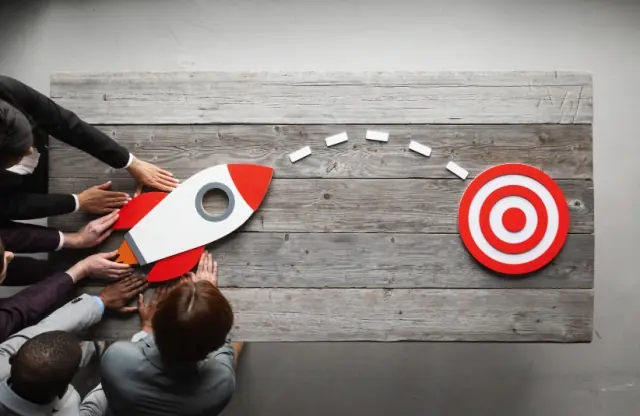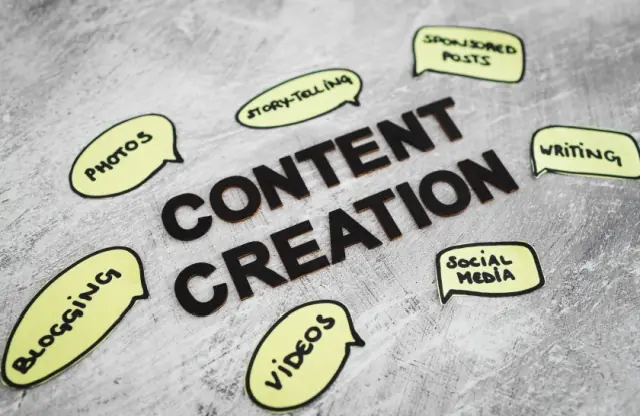
Content planning is essential for anyone trying to promote a product or service. It involves choosing and creating each piece of content carefully. This makes sure your message gets to the right people at the right time. Whether it’s a blog post, a tweet, or an infographic, picking the right type of content is key. This strategy helps you keep your message consistent and interesting on all platforms.
In this article, we’ll explain why content planning is important and what benefits it offers. We’ll look at how content planning is different from content strategy. We’ll also cover the main parts and elements of content planning, the various types of content strategies, and what goes into a content marketing plan. Plus, we’ll show you how to create a content plan that works with your content strategy. We’ll use an editorial calendar to keep everything organized. Get ready to learn how to improve your content planning skills!

What Is Content Planning?
Content planning is the process of organizing and strategizing content creation to achieve specific goals. These include boosting brand awareness, improving brand image, and enhancing brand positioning. It involves identifying the target audience and the type of content that will resonate with them. E.g., social media posts, blog articles, or videos. A key component of content planning is an editorial calendar. This helps you to schedule when to publish each piece of content, ensuring a consistent flow that aligns with your content marketing plan.
Start by setting clear objectives and understanding the audience’s preferences and pain points. This understanding helps in generating content ideas that are both appealing and relevant. Content planning also involves choosing the right channels for distribution to maximize reach and impact. Content planning is critical for businesses as it contributes directly to how the audience perceives the brand and can influence consumer behavior and business outcomes.
Effective content planning starts with thorough research. It involves teamwork and collaboration. The team must make continuous adjustments. These adjustments are based on performance analytics. They help refine strategies and achieve the desired impact.

Importance of Content Planning
Content planning is crucial for any business that wants to connect better with people online. Here’s why it matters, broken down so it’s easier to understand:
1. Enhances Understanding of Audience Needs
When you plan your content, you learn a lot about the people who will read or watch it. This helps you with content creation. You can create content that they will like and relate to, ensuring that you hit the mark every time.
2. Eases Stress and Improves Organization
Content planning helps you stay organized by mapping out what to create and when. This reduces the stress of last-minute content creation and ensures a smoother workflow. By having a plan, you avoid the panic of needing to generate ideas on the spot and create high-quality content as a result .
3. Achieves Business Goals
A clear content plan aligns each piece of content with your business goals. This could be increasing sales, generating leads, or enhancing brand awareness. Content planning makes sure your efforts directly support these goals. This makes your content marketing strategy more effective.
4. Ensures Consistency
It’s important to sound the same across all your posts and videos. Content planning helps keep your brand’s voice steady no matter where you’re posting. This makes your brand more recognizable and trusted.
5. Uses Resources Wisely
Planning your content helps you decide where to spend your time and money best, focusing on projects that will have the biggest impact. This way, you don’t waste resources and get more from your content marketing efforts.
6. Improves SEO and Drives Organic Traffic
Effective content planning involves keyword research and strategic content creation. This boosts your SEO. It makes your site more visible on search engines. This drives more organic traffic to your site. The better you plan, the higher your content will rank and attract visitors.
7. Helps You Adapt
Things online change fast, and having a plan makes it easier to adjust quickly. By keeping an eye on how well your content is doing and what your audience thinks, you can make changes to keep things fresh and interesting.
In short, content planning is not only about scheduling posts. It is about making sure every piece of content works hard to achieve your business goals. It’s a key part of any successful marketing strategy.
8. Enhances Measurement and Tracking
Content planning helps achieve goals and measure success. It provides a framework for setting benchmarks and tracking progress. This lets you see what works and what doesn’t. It leads to better planning for the future.
9. Saves Time
A detailed content plan allows you to work more efficiently. By knowing what you need to create in advance, you can batch-produce content, saving time in the long run. Reusing and repurposing content becomes easier, too, making your content marketing efforts more sustainable.
10. Allows for Spontaneity
Having a plan can increase creative freedom. With your content needs covered, you can be more spontaneous. You can experiment more and tailor content to current trends or feedback. This happens without the daily pressure of content demands.
11. Generates Leads and Conversions
Well-planned content aims to turn readers and viewers into leads and customers. Integrating calls to action and tailoring content for lead generation increases customer conversions.
12. Builds Brand Authority and Trust
Consistently delivering well-crafted content establishes your brand as an authority. This builds trust with your audience. A loyal audience is more likely to engage with your content. They are more likely to choose your services or products over competitors.
13. Cost-Effective
Content marketing, including content planning, costs less than traditional marketing tactics. It has lower initial costs. It also offers a better return on investment over time. This is because it keeps attracting and engaging users without ongoing costs.
Content planning is crucial for a successful content marketing strategy. It keeps you organized and helps meet your business goals. It also saves time and improves your online presence. Plus, it’s cost-effective. Investing in content planning tools and time to develop a strategy sets your business up for greater success. This enhances your digital presence.

Difference between Content Strategy vs. Content Content Planning
Content strategy and content planning are two important parts of successful content marketing. They each have different roles.
Content Strategy is the big plan for your content. It answers “why” you create content. You set the goals, know your audience, and decide the main messages. It makes sure your content matches your brand’s goals and values. You’ll do lots of research to understand what your audience needs and watch what your competitors are doing. You also set key goals to check if your content is successful.
Content Planning is about the “how.” It deals with actually making the strategy happen. You list the specific pieces of content to make, schedule when to make and share them, and decide where to share them. This planning makes sure you follow the strategy by organizing the workflow and assigning tasks. This step-by-step process helps you make content efficiently and on time.
While the content strategy sets up the vision and direction, content planning makes that vision happen by organizing the details. You need both parts: the strategy is like a map, and the planning is like the car that follows the map. Using both means your content reaches the right people in a planned way that fits with your larger business goals. Content planning tools can make managing and doing your strategy easier.
Together, they make sure each piece of content has a clear purpose and helps meet your business goals, like getting more website visits, increasing social media engagement, and boosting product sales.

Content Planning Components
Successful content planning requires a step-by-step, methodical approach. It involves clear procedures that focus on important parts of content creation. Here are key steps that are essential for any effective content strategy. They ensure every piece of content connects well with your audience and helps achieve your marketing goals.
1. Establish Goals
Every good content plan begins with clear goals. Setting specific, measurable, achievable, relevant, and time-bound (SMART) goals is foundational. This helps in creating high-quality content that serves a purpose, whether it’s increasing brand awareness, boosting SEO content, or driving more organic traffic to your website. Establishing clear goals guides all next planning steps.
2. Identify Your Target Audience
Understanding your audience is critical in content planning. You need to define who your target audience is through detailed audience personas. These personas should include demographic details, interests, preferences, and pain points. Knowing these details ensures that the content you create resonates with them. In turn, it makes your efforts more effective with target audience engagement across various social media platforms.
3. Do Comprehensive Research
Research underpins effective content planning. It involves analyzing existing content to identify what works and what doesn’t, studying competitors, and staying updated with industry trends. This comprehensive approach helps you spot opportunities for unique content ideas and ensures that your content is both relevant and competitive.
4. Choose Your Content Formats
Deciding on content formats is a strategic choice. One that your goals and audience preferences influence. Options may include blog posts, social media posts, videos, infographics, podcasts, and more. Choose content formats that best connect with your target audience and align with your content strategy. It will maximize engagement and effectiveness.
Map Out the Buyer Journey
Understanding the path your potential customers take from awareness to a decision is key. Map out the buyer’s journey to tailor your content to meet their needs at each stage. This strategic approach helps in creating content that assists, engages, and converts your audience throughout their journey.
These steps ensure your content not only meets the needs of your audience but also aligns seamlessly with your broader marketing strategies.

Content Planning Types
Content planning is essential for a successful content marketing campaign. Therefore, understanding the types of content planning is key to helping you target your efforts better. Here’s a breakdown of the three key types:
Brand Awareness
This type of content planning focuses on increasing the visibility of your brand. The goal is to inform potential customers about your company and what you offer. Content aimed at brand awareness is educational and designed to reach a broad audience. This can include social media posts, informative blog entries, and videos that highlight your product or service offerings.
Keywords
Keyword-focused content planning aims to improve your website’s visibility on search engines. By conducting thorough keyword research, you identify terms and phrases your target audience is searching for. Then, you create SEO content tailored to these keywords. This helps drive more organic traffic to your site. This type of content is crucial for boosting your site’s search engine rankings and visibility.
Conversion
Conversion content planning is designed to turn prospects into customers. It involves creating content that encourages users to take a specific action. Such actions could be signing up for a newsletter, buying something, or clicking through to another part of your website. Effective conversion content often includes strong calls-to-action (CTAs), compelling case studies, and persuasive product descriptions that guide the audience towards making a decision.
Together, these types of content planning ensure that every piece of content serves a specific purpose, supports the marketing strategy, and contributes to achieving business objectives. By employing these strategies, content planning ensures that your content is evenly distributed across various channels, aligns with your content creation process, and meets the needs of your audience at every stage of their journey.
What does a Content Marketing Plan involve?
Creating a successful content marketing plan involves several key activities, each contributing to the effectiveness of your marketing efforts. Here’s a breakdown of what each step involves, ensuring that content planning is thoroughly integrated into your marketing strategy:
1. Brainstorming Ideas
This initial stage is where your team comes together to generate content ideas that align with your marketing goals. It’s a collaborative effort to ensure that everyone considers a variety of perspectives and ideas. This enhances the creativity and relevance of your content.
2. Workflow Organization
Effective content planning requires a structured workflow. This involves defining each step of the content creation process, from ideation to publication, and assigning responsibilities to ensure smooth execution and adherence to deadlines.
3. Buyer Personas
Understanding your audience is crucial. Creating detailed buyer personas helps tailor your content to meet the specific needs, behaviors, and concerns of different segments of your target market.
4. Doing Research
This involves gathering data on market trends, customer needs, and competitor strategies. Thorough research supports the development of content that is both relevant and competitive.
5. Focusing on Customer Problems
Your content should aim to solve problems for your customers. Identifying and addressing these pain points can make your content more engaging and valuable.
6. Content Auditing
Reviewing your existing content can help identify gaps and opportunities for improvement. An audit ensures your content remains relevant and contributes effectively to your marketing goals.
7. Content Calendar
A content planning calendar helps organize and schedule your content production and publication. This tool is essential for maintaining a consistent content flow and ensuring timely execution of your content strategy.
8. Up-to-Date Content
Keeping your content current is vital for maintaining engagement and relevance. This might involve updating statistics, trends, and incorporating recent industry developments.
9. Measuring and Improving Content Performance
Measuring your content’s performance and making adjustments based on analytics as is key to improving your content’s effectiveness.
10. Involving Field Experts
Involving experts in your content creation can add credibility and depth to your content, making it more authoritative and trustworthy.
11. Delivering Your Message
How you deliver your content is as important as what you deliver. Effective message delivery ensures that your content is clear, persuasive, and resonates with your audience.
12. Authenticity
Authentic content builds trust and loyalty. It should reflect your brand’s values and speak truthfully to your audience’s experiences and needs.
13. What Formats to Post On
Deciding on the right formats and platforms for posting your content is crucial. You should base this decision on where your target audience is most active and engaged.
14. Creating Offsite Content
This includes content published outside your own channels, such as guest blogs or social media collaborations, which can extend your reach and influence.
15. Budgeting
Planning your budget is essential for effective content planning. It ensures that resources are allocated efficiently and can support your content production and promotion needs effectively.
Each of these steps contributes to a robust content marketing plan, ensuring that every aspect of content planning is strategically aligned with your business objectives and market demands.

Seamless Content Planning with Synapse
Mastering content planning is essential to the success of any digital marketing strategy. It helps you to create content that is not only engaging but also strategically aligned with your business objectives. At Synapse, one of India’s top branding and business communication agencies, we specialize in developing content plans that seamlessly integrate into your broader marketing strategies. Whether you are in India or any other continent, our team is ready to work with you to achieve your content marketing goals.
Let us help you execute your content strategy. Our experience ensures that we know how to produce content that resonates with your audience and meets your business needs. Visit the Showcase section on our website to see our portfolio, and check out our Services page to explore all that we offer.
Ready to start? Fill out the Contact Form, WhatsApp us, call us at 1800 121 5955 (India), or email us at contact@synapse.co. We look forward to crafting a content plan that drives your success.
FAQs on Content Planning
Q. What is content planning?
A. Content planning is the process of organizing, scheduling, and managing content creation ahead of time, usually with the help of a content calendar. It involves deciding what to publish, when to publish, and where to publish to meet specific marketing goals.
Q. Why is content planning important?
A. Content planning is crucial because it helps ensure that all content aligns with your business and marketing objectives, enhances consistency across your communication, and allows for strategic distribution across various channels. It helps maximize the impact of content on your target audience by ensuring it’s timely, relevant, and optimized.
Q. How do I start a content plan?
A. To start a content plan, first define your marketing goals and target audience. Conduct a content audit to assess what you already have and identify gaps. Then, brainstorm content ideas that align with your audience’s interests and your business goals. Finally, create a content calendar to schedule the production and publication of your content.
Q. What should be included in a content calendar?
A. A content calendar should include the publication dates, content topics, responsible creators, the platforms where the content will be published, and any deadlines for drafts and revisions. It may also include metadata like keywords for SEO, status updates, and any promotional tactics to be used upon publication.
Q. How often should I review and update my content plan?
A. It’s wise to review and update your content plan regularly, at least quarterly. However, it could be more frequent depending on the dynamics of your industry and changes in your marketing objectives. Regular updates ensure that your content remains relevant, engaging, and aligned with your audience’s current needs and preferences.







